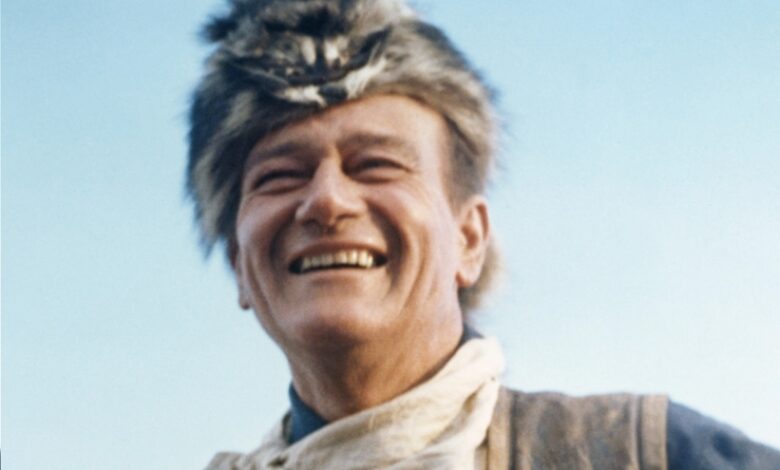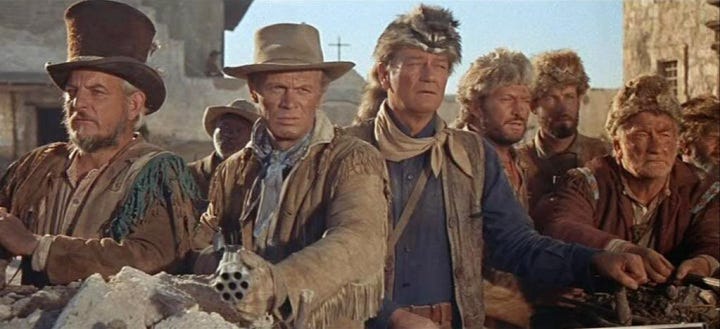Actor John Wayne had a very clear idea of what he believed the film industry should represent. He thought that motion pictures should be family entertainment, serving audiences of all ages. However, Wayne saw how the film medium started to embrace adult content, and he wanted to push back against it with every ounce of his star power.
John Wayne hated the modern trend of the film industry

Pilar Wayne and Alex Thorleifson’s book, John Wayne: My Life With the Duke, walked readers through film trends. They pointed to the country’s move toward “liberalism,” which reflected on the type of movies Hollywood wanted to make. Explicit violence and sex became further infused into the mainstream.
Wayne fans were familiar with his Western film titles with choreographed violence. However, even that genre depicted more graphic violence. As a result, Wayne wanted that to change.
“He believed that all the bloodletting on screen, the gratuitous sex, was bound to weaken the fiber of U.S. society,” Pilar wrote. “He was prepared to fight that trend with every ounce of his star power and box office appeal.”
John Wayne made ‘The Alamo’ in response to those who ‘didn’t believe in good, old-fashioned American values’

John Wayne: My Life With the Duke explored the journey the actor went on to make a film he wanted to make a reality for many years. He turned to make The Alamo in response to the trend of increasing the amount of sex and violence in cinema. The story follows a small band of soldiers who sacrificed their lives to stop a tyrant from destroying the new Republic of Texas. However, the film industry didn’t share the vision that Wayne saw for The Alamo.
“In Duke’s opinion, the time was ripe to film the saga of the Alamo–a story of sacrifice, courage, and devotion,” Pilar wrote. “The film would be his response to all the flag burners, drag dodgers, and the fainthearted who didn’t believe in good, old-fashioned American virtues.”
However, the most critically acclaimed movies at the time were La Dolce Vita, Never on a Sunday, and Elmer Gantry, which all fit in with the film trend Wayne detested.
“Most of Hollywood’s movers and shakers thought he’d lost his mind,” Pilar wrote. “They looked at James Grant’s script and saw no sex, no nude scenes, no decapitated bodies flying through the air. ‘Who the hell is going to pay to see a picture where all the heroes die?’ Herbert Yates scoffed when Duke approached him in search of funding. Despite their many past successes, Jack Warner had no interest in putting money in Duke’s film either. ‘It’ll be too goddamn expensive, and I don’t think the fans want to see this kind of picture anymore.’”
Pilar continued: “Warner was right on one count. The Alamo would cost more than any movie up to that time, over $10 million–and Duke would have to mortgage our home and our future in order to complete it.”
The actor earned an Oscar nomination for Best Director
The Wayne film earned mixed reactions from critics. The Alamo currently sits at a 52% approved critics score on Rotten Tomatoes and 64% audience score. “John Wayne proves to be less compelling behind the camera than he is before it in The Alamo, a blustery dramatization of the fort’s last stand that feels more like a first draft,” the critics consensus reads.
Nevertheless, The Alamo would go on to earn one Oscar win and six additional nominations. It won for Best Sound, but only earned nominations for Best Picture, Supporting Actor, Cinematography, Film Editing, Original Song, and Music. This is the second Oscar nomination that Wayne got after his performance in the film Sands of Iwo Jima. He would finally secure a golden statue with 1969’s True Grit for Best Actor.
